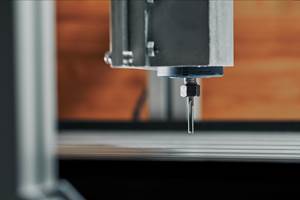DNC With A Direction
A small shopfloor network lays the groundwork for large-scale, low-cost DNC throughout a major manufacturing facility.
What if you could begin again with your system for sending NC files to the machine tools? What if you could be free of the hardware choices you made in years past?
The mold shop belonging to Karl Schmidt Unisia's piston manufacturing plant in Marinette, Wisconsin, got exactly that chance. A fresh start was justified because the system of sending programs to the CNCs across serial connections was failing the shop too often. The primary problem was not the slowness of the RS-232 serial interface at the CNC, but instead the vulnerability of the cable connecting to this interface. Programs were often corrupted. Drip-fed files would be lost in mid-cut. The shop needed a network that could accomplish DNC (distributed numerical control) with more dependability.
But this shop had other requirements, too—requirements that went beyond what is typical for a mold shop. The hardware used in the network had to be so economical, both to install and to maintain, that the network might be expanded to many more machines. And in other ways than this, the new system had to be forward-looking enough to anticipate applications far removed from mold machining.
The Marinette facility is an 850-employee plant producing as many as 15 million pistons per year. Applications for the pistons include cars, trucks, heavy equipment, marine engines and recreational vehicles. The mold shop—which uses EDM and milling in steel to produce permanent molds used in casting—is only a small part of the total facility. While this shop has always relied on DNC, efficient program transfer is less crucial in the various areas of the plant where pistons themselves are machined. In these areas, the NC files are generally short lathe programs, and a given program may run hundreds of thousands of pieces before the program is changed. But even so, a DNC system with the right characteristics could also let the production areas operate more efficiently. The company recognized this, and designed the mold shop's network with an eye toward eventually extending this same system to meet the very different needs of the machine tools that turn pistons.
The fundamental features of a DNC system able to meet these disparate needs include the following: (A) a Windows-based environment—which is what the mold shop's DNC system now employs—combined with (B) wireless communication and (C) Web-based architecture for the user interface.
At Karl Schmidt Unisia, the mold shop often can't justify the latest technology. Employees in this department understand an often-repeated principle—that the business of the company is to make pistons, not molds. The shop has a high speed vertical machining center and has a high speed horizontal machining center on order, but in addition to these machines, the shop's mix of machine tools also includes a pair of 12-year-old CNC knee mills that are still used routinely and effectively. The new shopfloor network delivers programs to the complete range of these machines.
Data Defense
Many mold makers are familiar with the "data starvation" that can result from using an RS-232 interface to drip feed an NC program. ("Drip feed" refers to downloading a program to the CNC's memory buffer while the CNC is running that program.) Mill at too high a feed rate during drip feeding in some detailed region of the part where the tool path is divided into short line segments, and the machine may hesitate—executing program blocks more quickly than they can be delivered to the control. This is a common problem with drip feeding, but it was not the primary problem with drip feeding in the piston maker's shop.
So says Ken Salzman, the corporate information systems manager. He says the mold shop can reduce data starvation's impact by assigning the most fine-detailed molds and electrodes to the high speed machining center. This machine has enough CNC memory to store even a large program in its entirety, making drip feed unnecessary. (The download is completed before the program runs.) For complex work run by drip feeding to older machines, he says, it has been the cable—not the serial port—that limited how quickly the data could be sent.
This is significant. The newly installed network keeps the serial ports but does away with the cable. Or more accurately, it does away with long cables, replacing them with much shorter connections.
Don Stephenson of Fujitsu Consulting installed the new network. He says the bottleneck imposed by the cable is a little-appreciated aspect of drip feeding across a serial connection. The cable is a capacitor, and its capacitance increases with increasing length. All but the oldest CNCs offer serial ports able to receive data fast enough to mill at a reasonable feed rate, he says, but the data may have to be fed at a rate slower than what the connection will allow to prevent the cable's influence from corrupting the signal.
And even when data are fed slowly, the signal might still be corrupted. The mold shop's most significant problem with serial drip feed was its vulnerability.
A serial cable is relatively unshielded against electromagnetic noise. The field from a computer or an electric motor might cause just one bit of data crossing the cable to be lost. When this happened in the mold shop, the program usually became illegible at the point in the program where the corruption occurred. As damaging as this was, it was better than the much more rare alternative—the program remaining legible, but now with one of its numbers changed.
Whenever a machine tool froze because a program it was executing had become unreadable, the mold shop had two choices. It could either start the program again from the beginning, cutting air through the tool paths it had already run, or else it could delete all of the program prior to the last successful tool change and start again using only this much. One choice was time-consuming, and the other choice posed a risk of error.
The CNC on the mold shop's high speed machining center avoids this problem altogether. Like most modern CNCs, it replaces the serial connection with a network connection for transferring files via Ethernet. Ethernet permits much faster data transfer, but what is just as important, it also provides for secure data transfer. The file received is compared to the file at the source to ensure that every one of the bits survived the trip.
As the architecture of the primary corporate network, Ethernet was already used to transfer NC files at the Marinette facility, but it didn't reach all of the way to the machines. In the mold shop, a terminal server received the Ethernet input, and connected via long serial cables to the various CNCs.
Mr. Salzman knew that letting Ethernet reach farther was the key to improving the performance of the rest of the mold shop's machines. However, retrofitting all of the mold shop's machining centers with new CNCs capable of Ethernet would have entailed an enormous expense. It also would have been overkill. Because the problems stemmed from the serial cables' length, all the shop truly needed was for Ethernet to cover as much of the distance as possible, letting a tiny serial cable complete the connection.
In addition, using PCs at each machine would have been overkill, too. There was no need to provide an interface at each machine, just secure data transfer.
What the new network uses instead are serial port servers—one of which now resides inside each CNC cabinet in the shop. These black boxes (literally—they are box-shaped and colored black) act like single-channel versions of the previous DNC server. Each one receives Ethernet input and feeds the data to the CNC across a brief serial connection, now enclosed entirely within the cabinet.
The first serial port servers to be installed were custom made, but since that time, generic hardware accomplishing exactly the same thing has become available. The servers can now be ordered off the shelf. And as costs continue to come down, the Marinette facility has a vision for how much farther the DNC network will reach.
One other change to the system for sending NC files to CNCs was the move from the old terminal server's character-based environment to a Windows-based environment. This resulted in a system that was easier to use and easier to support. However, the change was also made so the system could eventually support wireless communication and a Web-based interface, two features whose significance lies outside of mold machining.
Ethernet And Internet
What a production area needs in a DNC network is very different from what a mold shop needs. Compared to the mold shop's long milling programs, the NC file for a typical production job is short enough to fit in the memory of even an old CNC, meaning no drip feed is required. In addition, these short programs are downloaded infrequently, because a machine may run the same part in the same way for months on end. That is certainly not the case in the mold shop, where every new workpiece comes with a new NC file.
There is also a difference of scope. At the Marinette facility, the mold shop has eight CNC machining centers. The various areas of the plant that machine pistons include more than 200 CNC machines.
These factors affect the economic viability of a DNC network. Specifically, they affect the cost-justification of dedicating hardware to NC file transfer. Even in its current form, the mold shop's DNC network still uses a fair amount of hardware, requiring the serial port servers to connect by network cable to a shopfloor PC providing the user interface. Applying precisely this same solution across the plant's production areas would require large expenditures for stringing cable and for stationing hardened PCs throughout the plant. The low-tech alternative—delivering programs physically on a diskette or a portable PC—represents a much more cost-efficient system.
However, the network can now be implemented in a way that overcomes much of the hardware expense. Wireless communication eliminates the need for cable, and it also eliminates the need for PCs to be hard-wired into fixed locations. Meanwhile, creating a Web-based interface means no PCs have to be dedicated, because any PC with a Web browser can be used to perform program management. In fact, shop foremen could carry Internet-enabled PDAs (personal data assistants) specifically to make NC file transfers.
At this writing, Mr. Stephenson is working on the Web-based version of the interface currently used in the mold shop. The challenge with a Web-based DNC system is that the Web is a "stateless" environment. It delivers discrete packets of information—the elements of a Web page, for example—without any concern for the data transfer rate. The Web cannot deliver a steady signal in need of continuity such as a drip-fed NC file.
To address this limitation, Mr. Stephenson is using an "n-tier" architecture for the DNC system. Within this system, the user interface and the delivery of the program occupy different "tiers" that interact with one another. Only the user interface is Web-based. Delivery of the program relies on a different architecture that runs continuously (the accepted term is "state-full"), and therefore is capable of a steady transmission.
DNC By Degrees
Other parts of the plant suggest where the next steps will be in the direction of expanded DNC service. In addition to the mold shop and the various large-volume production areas, the plant also has a prototype department where new piston models are machined in small batches so that the design and the production process can be proven out. Yet another area is an aftermarket department where pistons no longer produced in large runs are machined in small batches for sale as service parts.
In both of these areas, NC programs are small—like production programs—but program changeover is more frequent, similar to that of the mold shop. The need for DNC here is less urgent than that of the mold shop but more pressing than the need for DNC in full production. Accordingly, these areas rely on a partial Ethernet solution similar to what the mold shop used to use. In place of a terminal server, each of these areas now uses a multiple-output serial port server to bring Ethernet part of the way to the machines. Long serial cables span out from the location of the multi-port server to close the connections.
With these servers, DNC in these areas has been upgraded to a Windows environment. And in the future, when the cost comes down for individual serial port servers comparable to the ones used in the mold shop, the individual servers can be applied to CNCs in these areas, as well—to let Ethernet reach the rest of the distance.
In other words, the plant's capabilities in the future won't be mired by the limits of the technology that happens to be affordable today. The company's DNC system is poised to advance, expanding across the facility just as quickly as the hardware becomes more accessible.
Related Content
When to Use Custom Macros With a CAM System
Custom macros can offer benefits even when using a CAM system to prepare programs – but must be implemented with the right considerations.
Read More6 Steps to Take Before Creating a CNC Program
Any time saved by skipping preparation for programming can be easily lost when the program makes it to the machine. Follow these steps to ensure success.
Read MoreFive Safety Considerations for CNC Machinists
Safety in CNC environments is essential for users – and for productivity. Consider these 5 points to avoid injury, part failure and downtime.
Read More5 G-Code Tips for Increasing CNC Efficiency
Optimizing G code is a low-cost way to improve CNC efficiency without sacrificing usability and safety.
Read MoreRead Next
The Cut Scene: The Finer Details of Large-Format Machining
Small details and features can have an outsized impact on large parts, such as Barbco’s collapsible utility drill head.
Read More3 Mistakes That Cause CNC Programs to Fail
Despite enhancements to manufacturing technology, there are still issues today that can cause programs to fail. These failures can cause lost time, scrapped parts, damaged machines and even injured operators.
Read More
.jpg;width=70;height=70;mode=crop)



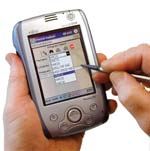

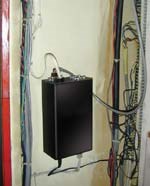
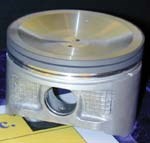
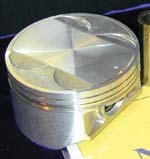










.png;maxWidth=300;quality=90)



.png;maxWidth=300;quality=90)








